
The Best DNA and Ancestry Products Compared
What is a Haplogroup?
A haplogroup is a DNA sequence that you can find after taking a home DNA test. You can learn about this group and what it tells you.
Advertising Disclosure
Many or all of the companies featured provide compensation to us. These commissions are how we maintain our free service for consumers. Compensation, along with hours of in-depth research, determines where & how companies appear on our site.
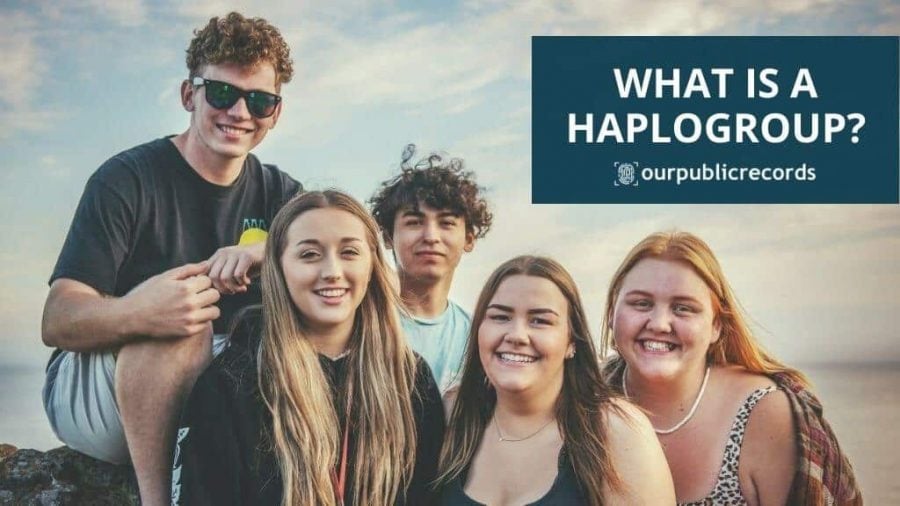
DNA Testing and Haplogroups
Doing a home DNA test done is one of the best ways to finally lay rest to those old family legends you heard over the years. You can get definitive proof in black and white that your ancestors migrated from one country and settled in a region of the United States. Most tests will also let you know if your family lived in different parts of the country or the world. Though most of the information you receive is easy to read and understand, you might come across some confusing terms such as haplogroup. Ancestry and all the other major testing companies use this term at least once in your results.
A haplogroup is essentially a term that describes the tribe or cultural group that your ancestors belonged to in the past. You might learn that you’re part of the aboriginals from Australia, that you have Native American blood from one or more tribes or that your family can trace their roots back to the Vikings. Some companies will list the female and male haplogroups connected to your sample and let you trace your family back farther than you thought. In this article, we’ll look at the types of haplogroups and what they can tell you.
Each Haplogroup Relates to a Specific Continent or Country
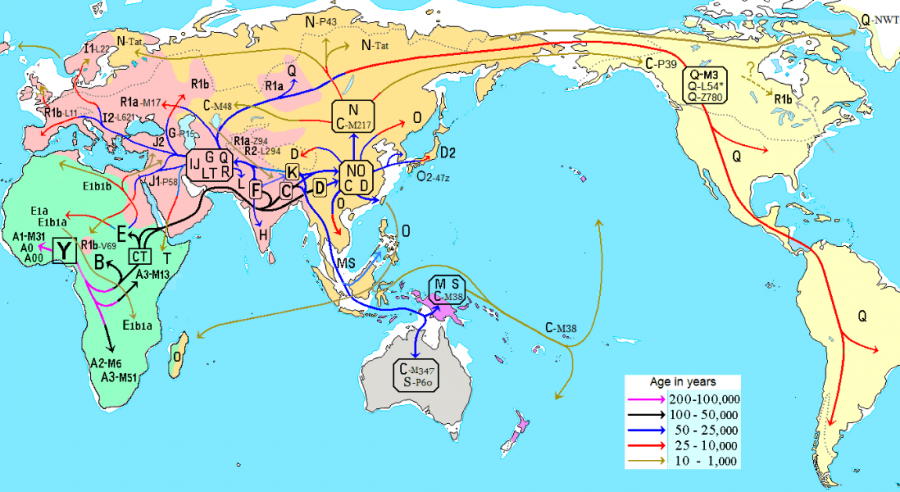
Photo by Maulucioni under License CC0 1.0 CC BY 3.0
Female vs. Male Haplogroups
One thing you need to understand is the difference between Y-DNA and mtDNA. Y-DNA refers to the male line of your family and DNA that exists from one generation to the next. If you are a woman, you cannot have this type of test done. Only men can opt for a Y-DNA test because they’re the only ones who have Y-DNA. FamilyTree DNA is a popular testing choice for those who want to see where their male family members once lived. The DNA samples that they provide share chromosomes with their fathers, grandfathers and generations that go back even more in time.
Women can opt for an mtDNA test. Also called a mitochondrial DNA test, it lets the company test a woman’s DNA and reveals information about her mother, grandmother and other women in her family line. With an mtDNA test, you can see what health conditions are related to your genes too, including certain types of cancer and both hearing and hair loss. Haplogroups follow a familial line on the mother’s side or the father’s side. With one test, you can see where your family started and when they separated from early decedents. This can also reveal how your family immigrated to the US and other regions.
Haplogroup Mapping
The easiest way to use your haplogroup is with the mapping that your testing company offers. Ancestry.com offers an easy to use map that shows you where your family lived at different points in time. Once you log into your account, you can click on the map button to load it. You’ll notice dates listed at the bottom of the page that you can click on too. When you click on any date, you can see where your family lived at that point. You might notice that most of your family lived in Eastern Europe up through the late 19th century and that they moved to the West Coast or Appalachia near the turn of the century. The test allows you to see how many people who share your DNA and belong to your haplogroup right now also.
Every person in the world today descends from somewhere in Africa. Those tribes later split into other groups who moved around the world. Many people who identify as white found that they were up to 6% African when they took a DNA test. If your family spent several generations living in Europe and North America, your African percentage might be much lower.
Some DNA tests let you view where your ancestors once lived and where your relatives currently live.
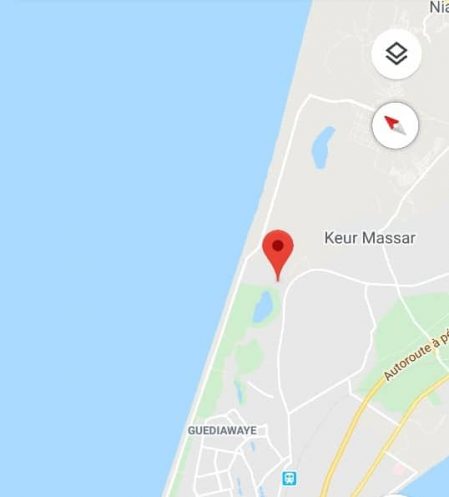
What Affects a Haplogroup?
The main thing that affects your haplogroup is where your family moved after leaving Africa. During the early days of humanity, there was just one African haplogroup. As those groups changed and moved to other parts of the continent, more haplogroups formed. Even more formed as those groups moved to Asia, Europe and other continents. Haplogroups form when one tribe or group of people have genes that mutate and transform. Though some mutations are quite intense and can change the entire group, others are quite minor and make no noticeable changes to that group. It usually takes two or more generations for that mutation to grow to the point where it becomes a haplogroup.
A good example is the Fugate Family of Kentucky. During the early 19th century, members of this family became known for their bright blue skin. This mutation slowly disappeared over the years until one of the family’s ancestors developed the condition in the 1970s. Researchers today hope that DNA tests can help solve the mystery of the blue-skinned family. If your family comes from southern Kentucky, you may find that you carry the gene for blue skin too.
Adam and Eve
Even if you don’t follow the teachings of the Bible, you should still believe in Adam and Eve. These are the names given to the shared ancestors all people had. Adam and Eve were a man and woman who lived in Africa approximately 200,000 years ago. Researchers showed that women descended from Eve and nicknamed her Mitochondrial Eve. All men descended from Adam who earned the nickname Y-Chromosomal Adam. Though you might think that this means they were the only two people on Earth, that isn’t true. Scientists believe that other people were alive at the same time but that the genes of Adam and Eve were strong enough that they still exist in the humans who now walk the Earth.
According to this idea, our species split from a phylogenetic tree. This tree starts with either Adam or Eve and then splits into different branches based on where people lived and who they married and had children with, which changed the genes of future generations. Whether you are male or female, you have a genetic tree with branches that correspond to your maternal and paternal lines. Each branch on that tree relates to a different haplogroup.
You can see how the branches of your family tree connect to either Adam or Eve.
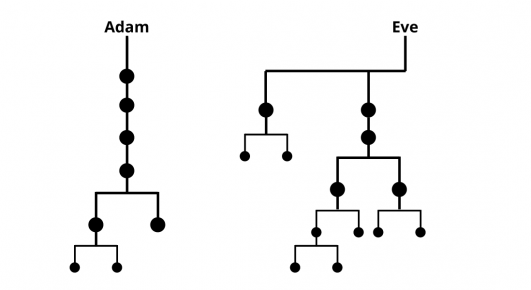
Main Haplogroups Today
When you get DNA tests done today, you’ll find that most tests divide haplogroups into four categories. Those groups include:
- European
- Native American
- Asian
- African
You might see that list and wonder how it applies to your results because the test you took shows so many other groups. This is because those companies use sub-groups that breakdown each haplogroup into smaller and more defined categories. For example, the European haplogroup can include Irish, French and British sub-groups. Your haplogroup should include at least one African group as well that shows where your family line started. Some tests may include two or three groups under the Native American haplogroup too.
The results that you get will list each haplogroup with a letter and a number. It starts with the earliest haplogroup in which the company discovered your DNA. The name may include numbers or letters that relate to the geographic area of that group, how they connect to other haplogroups and when they first started. If you want to trace the exact routes that your ancestors followed and see when they moved to each region or area, you’ll want to take a detailed look at all the haplogroups shown in your DNA test results.
Bigger is Better
In the case of haplogroups, bigger is usually better or at least longer is better. The sub-group information that you get can include a long combination of letters and numbers. You can trace that combination back to see where your family lived, and you may even find that you can see the exact county or town where they once lived. One of the more popular sub-groups for those from Ireland is that of Niall of the Nine Hostages. Niall was a warrior and sometimes called an Irish High King. He created an entire haplogroup that includes more than three million people from around the world.
Though you might think that you can use a haplogroup to prove that you came from a specific person in a Native American tribe or a certain person, you shouldn’t rely on these tests to prove ancestry. In the past, people began using surnames as a way to show that they belonged to the same group of people. Many of these names came from the professions they had such as bakers who used the surname, Baker. Haplogroups allowed you to find more information about your family before they began using a surname.
Most Popular Surnames
- Smith
- Johnson
- Williams
- Brown
- Jones
- Miller
- Davis
- Wilson
How to Use a Haplogroup in Genealogy
The number one reason why people take home DNA tests is that they want to learn about their heritage. These tests give you more information than your parents and grandparents can and will give you details that your family may not know. Once you have a haplogroup name in front of you, you can trace that group back and see that last person in your family who was part of that group. Depending on whether you are male or female, you can trace your roots on your father’s side or mother’s side. This will let you go back in time to find the last clan affiliated with your family.
Let’s say that your DNA test revealed that your family is primarily French. Chauvet is a small town in France known for cave paintings that date back centuries. The painters responsible for those images belong to a certain sub-group. When you compare your haplogroup to that sub-group, you can see if your family came from the same region and if any of your ancestors were cave painters. The same holds true for any specific group of people at any point. You can see if you share genes with any haplogroup, including ancient Chinese warriors or Native American tribes.
Best Places to Research Your Genealogy

- Cemeteries
- Churches
- Tax offices
- County records
- Courthouses
- Public records
- Family Bibles
- Genealogy libraries
Photo by Cofrin Library under License CC BY 2.0
Your Haplogroup Branches
As we explained above, you have a genetic tree that includes paternal and maternal branches. The Y-DNA side of your tree includes 18 branches, but there are 26 branches on your maternal side. Any haplogroup that relates to male DNA will have a name that starts with a letter ranging from A to R. A series of letters and numbers will then follow that letter to help you better identify your genetics. R1A is one of the more common combinations that you might see. Though the branches on your maternal side will also include a combination of letters and numbers, each branch will start with a letter from A to Z.
Most home DNA tests break down those branches into both haplogroups and sub-groups. You can use the main haplogroup to get an idea of which were the prominent groups connected to your family since they moved from Africa. The individual letters and numbers that follow help you narrow down the smaller groups they belonged to within a specific region. For example, a test might show that 67% of your genes come from the United Kingdom. When you break down the results, you may find that you are British, Irish, Scottish and Celtic.
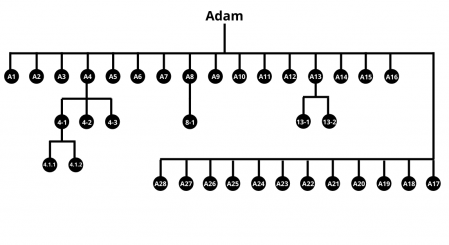
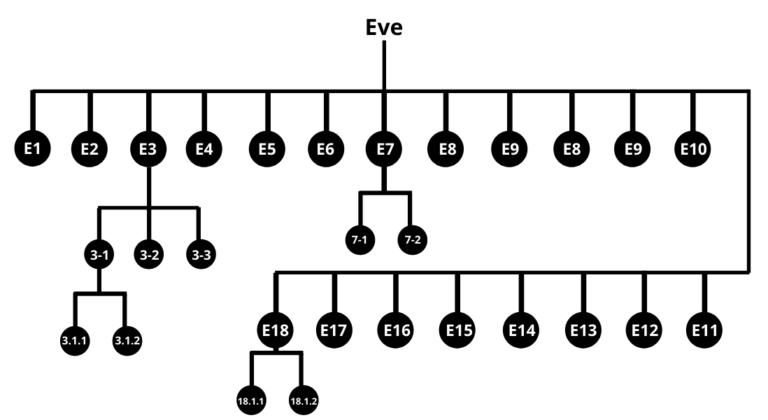
Native American Haplogroups
If every person who claimed they were related to Native American royalty gave us $1, we’d be rich. You might hear friends or coworkers claim that they have Cherokee princesses in their family lines when that tribe didn’t have princesses. Another reason some people claim they are Native American is that their ancestors married and had children with African Americans. It was illegal to marry people of color in the south and other parts of the country for many years. When doing genealogy research, you can use marriage and birth records to see who your ancestors married and when they lived, died and had children.
Even if you trace your roots back to a Native American haplogroup, you may find that you belong to Asian haplogroups too. This happens because some of the early people who immigrated to North America came from Asia. As this event happened more than 10,000 years ago, their genes mutated as they became more accustomed to living on the continent. Most people with Native American genes had ancestors who crossed the Bering Land Bridge near modern-day Alaska. The combination of letters and numbers in your haplogroup can indicate that your family came from Southeast Asia, Northwest Asia or other parts of the continent. Some haplogroups can tell you where your ancestors were 50,000 years ago or longer.
What are some of the Largest Native American Haplogroups?
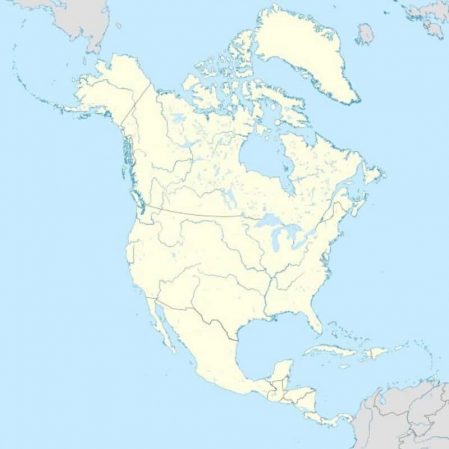
Photo by Uwe Dedering under License CC0 1.0 CC BY 3.0
Oldest Haplogroups
One of the oldest haplogroups is one that experts define as a mega haplogroup called Group F. Haplogroup contains a sub-group called Haplogroup H. Many of the people who came from this haplogroup now live in Sri Lanka and India, though some are also related to the Roma culture. Some evidence shows that this group started around 30,000 years ago and that they primarily lived in Eastern Africa. They later moved to India and settled nearby.
Haplogroup I is significantly older than other groups too and likely started 25,000 years ago. The members of this group lived in Southern Europe and the eastern parts of the continent. During the Ice Age, the members moved north through Europe to escape the cold. Both Haplogroups I and H include paternal DNA.
Your mtDNA can also include genes relating to Haplogroup H. Not only is this one of the largest haplogroups, but it includes millions of people in Europe and other westernized nations. Scientists believe that this group started in Europe but later mutated as members moved to the Middle East. Your maternal line may include Haplogroup X too, which shares some connections with Haplogroup N. This genetic line began up to 30,000 years ago before breaking into two sub-groups. X1 is a sub-group that includes people from Eastern and Northern Africa, while X2 includes groups in the Mediterranean.
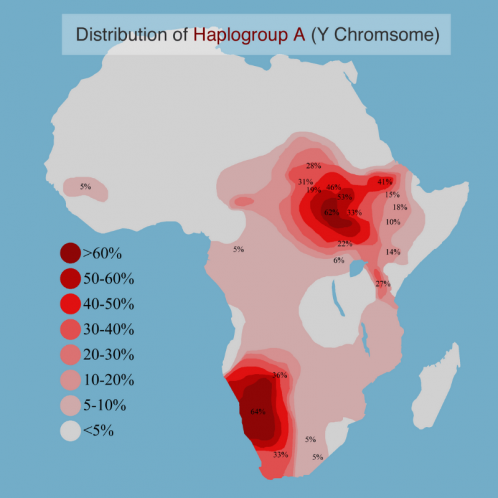
Haplogroup A includes many people who had ancestors living in Africa during ancient times.
Photo by Andrewwik.0 under License CC0 1.0 CC BY 3.0
Haplogroups and Genetic Testing
Genetic counselors help those with a family history of medical conditions and diseases find out if they have the genes that put them at risk of suffering from those same conditions. If you worry about meeting with one of those counselors, you can have a DNA test done first. One important reason to look at your haplogroups is that you can use see what conditions correlate to those groups. Some tests can show if you are at risk of developing diabetes, which occurs when your body cannot process the sugar that you eat. You may need to take medication or use insulin daily to cope with your diabetes.
Other conditions that can correlate with certain haplogroups include Alzheimer’s disease and Parkinson’s disease. Parkinson’s can make it hard for you to live a normal life because your hands and other body parts shake. That shaking can affect your ability to fee yourself and take care of your home and loved ones. With Alzheimer’s, you may not realize that you have a problem. This disease interferes with thoughts and memories. It can make people forget where they live, who their loved ones are and how to do basic tasks. Those with a family history of Alzheimer’s are more likely to develop the disease.
Symptoms of Alzheimer's Disease

What to do with Your Haplogroup
There is only so much information that you can get from one DNA test. Ancestry.com, FamilyTree DNA, 23andMe and other companies offer great packages that show you when your family line started, where your ancestors lived and where they moved to as they joined groups and changed homes. Each test gives you some basic information in the form of a raw data profile. Depending on which test you choose, you might see that your family lived in Southern Asia and then moved to Korea or Vietnam before immigrating to the United States. With your raw data, you can upload your profile to GEDmatch and find out even more.
In our article on GEDmatch, we go over what this site is and how it works. It’s essentially an online tool that lets you find people from the same haplogroups who share your genes. Once you create a new account, you can upload the raw data from your kit. The site accepts results from all the major websites and also lets you upload results from new testing sites. You can then access tools that let you see if your parents share genes, you match with another user who took a test or what mixture of genes you have.
What Can You do with GEDmatch?
- Compare your results with another user
- Check your sample against millions of other users or the general population
- Find users who matched your results on up to two kits
- See how your results from one test compare to the results from another
Which DNA Test is Best for Haplogroups?
In our 23andMe vs. Ancestry, you can see how the DNA tests from Ancestry.com compare to the ones offered by 23andMe. Many of the shoppers who choose 23andMe want to get a look at some of the fun results that they get back. This is the only test that can tell you if you have the genes that make cilantro taste like soap or if you have a greater risk of having back hair than other people do. Both tests include some haplogroup information and are solid choices for those who want to do genealogical research. Another option you might like is MyHeritage, which has fewer groups but often costs less money.
Every company that does home DNA testing will give you results that show what groups or categories you share genes with, which are similar to haplogroups. Do not assume that you should pick the test that offers the largest number of groups though. Most companies simply break one specific region into smaller groups. Instead of stating that you are 54% French, the test might show that you’re 22% Southern French and 32% Northern French. Choosing a test with more groups is only necessary if you want to see the regions where your ancestors lived.
What Traits Does 23ndMe Show?
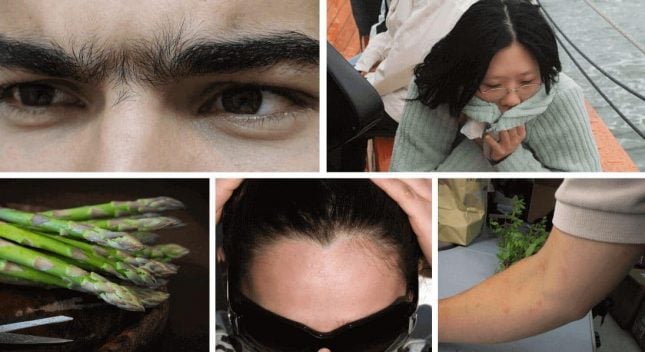
- Asparagus odors
- Motion sickness
- Unibrow
- Widow's peak
- Stretch marks
- Mosquito bites
Motion Sickness Photo by LiteTouch Photography under License CC BY 2.0, Unibrow Photo by Z11o22 under License CC0 1.0 CC BY 3.0, Widow’s peak by Kuebi under License CC0 1.0 CC BY 3.0
Doing More with Your Results
If you know that you have Native American or African American ancestry, you’ll want to choose a test designed for people from those haplogroups. Though some tests claim that they check for Native American groups, they may not give you as much information as you want because those groups are so closely related. Dozens of tribes lived in Kentucky at the same time and traveled together west. It’s often hard to distinguish between those tribes. We offer detailed articles on both the best DNA test for African Americans and the best options for Native Americans that you can use when picking a test.
Regardless of the test that you choose, you can do more with your results than simply look at them online and save a copy to your computer. Some sites accept the results that you get from another kit and let you compare the results. This is a great way to see if 23andMe and Ancestry.com match or if the results that you get from a new kit match those you got from an old one. Most sites give you the option of connecting with other registered members and talking about your family online too. This lets you find fourth cousins and other distant relations with the same ancestors. You can even create a family tree and include some of those new relatives on your exterior branches. With the DNA kits that are now available, you’re only weeks away from finding your haplogroups and ancestors.
